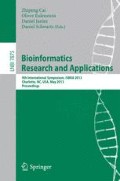Abstract
Changes of gene ordering under rearrangements have been extensively used as a signal to reconstruct phylogenies and ancestral genomes. Inferring the gene order of an extinct species has the potential in revealing a more detailed evolutionary history of species descended from it. Current tools used in ancestral reconstruction may fall into parsimonious and probabilistic methods according to the criteria they follow. In this study, we propose a new probabilistic method called PMAG to infer the ancestral genomic orders by calculating the conditional probabilities of gene adjacencies using Bayes’ theorem. The method incorporates a transition model designed particularly for genomic rearrangement scenarios, a reroot procedure to relocate the root to the target ancestor that is inferred as well as a greedy algorithm to connect adjacencies with high conditional probabilities into valid gene orders.
We conducted a series of simulation experiments to assess the performance of PMAG and compared it against previously existing probabilistic methods (InferCARsPro) and parsimonious methods (GRAPPA). As we learned from the results, PMAG can reconstruct more correct ancestral adjacencies and yet run several orders of magnitude faster than InferCARsPro and GRAPPA.
Access this chapter
Tax calculation will be finalised at checkout
Purchases are for personal use only
Preview
Unable to display preview. Download preview PDF.
References
Kent, W., Baertsch, R., Hinrichs, A., Miller, W., Haussler, D.: Evolutions cauldron: duplication, deletion, andrearrangement in the mouse and human genomes. Proceedings of the National Academy of Sciences 100(20), 11484–11489 (2003)
Muller, K., Borsch, T., Legendre, L., Porembski, S., Theisen, I., Barthlott, W.: Evolution of carnivory in Lentibulariaceae and the Lamiales. Plant Biology 6(4), 477–490 (2008)
Moret, B., et al.: A New Implmentation and Detailed Study of Breakpoint Analysis. In: Pacific Symposium on Biocomputing (2001)
Guillaume, B., Pevzner, P.: Genome-scale evolution: reconstructing gene orders in the ancestral species. Genome Research 12(1), 26–36 (2002)
Max, A., Pevzner, P.: Breakpoint graphs and ancestral genome reconstructions. Genome Research 19(5), 943–957 (2009)
Ma, J.: A probabilistic framework for inferring ancestral genomic orders. In: 2010 IEEE International Conference on Bioinformatics and Biomedicine (BIBM). IEEE (2010)
Sankoff, D., Blanchette, M.: Probability models for genome rearrangement and linear invariants for phylogenetic inference. In: Proceedings of the Third Annual International Conference on Computational Molecular Biology. ACM (1999)
Sophia, Y., Attie, O., Friedberg, R.: Efficient sorting of genomic permutations by translocation, inversion and block interchange. Bioinformatics 21(16), 3340–3346 (2005)
Xu, A.W., Sankoff, D.: Decompositions of multiple breakpoint graphs and rapid exact solutions to the median problem. In: Crandall, K.A., Lagergren, J. (eds.) WABI 2008. LNCS (LNBI), vol. 5251, pp. 25–37. Springer, Heidelberg (2008)
Hu, F., et al.: Maximum likelihood phylogenetic reconstruction using gene order encodings. In: 2011 IEEE Symposium on Computational Intelligence in Bioinformatics and Computational Biology (CIBCB). IEEE (2011)
Lin, Y., Hu, F., Tang, J., Moret, B.: Maximum likelihood phylogenetic reconstruction from high-resolution whole-genome data and a tree of 68 eukaryotes. In: Proc. 18th Pacific Symp. on Biocomputing, PSB 2013, pp. 285–296 (2013)
Yang, Z., Sudhir, K., Masatoshi, N.: A new method of inference of ancestral nucleotide and amino acid sequences. Genetics 141(4), 1641–1650 (1995)
Felsenstein, J.: Evolutionary trees from DNA sequences: a maximum likelihood approach. Journal of molecular evolution 17(6), 368–376 (1981)
Stamatakis, A.: RAxML-VI-HPC: maximum likelihood-based phylogenetic analyses with thousands of taxa and mixed models. Bioinformatics 22(21), 2688–2690 (2006)
Stamatakis, A.: New standard RAxML version with marginal ancestral state computationas, https://github.com/stamatak/standard-RAxML
Tang, J., Wang, L.: Improving genome rearrangement phylogeny using sequence-style parsimony. In: Fifth IEEE Symposium on Bioinformatics and Bioengineering, BIBE 2005, pp. 137–144. IEEE (2005)
Jahn, K., Zheng, C., Kováč, J., Sankoff, D.: A consolidation algorithm for genomes fractionated after higher order polyploidization. BMC Bioinformatics 13(suppl. 19), S8 (2012)
Ma, J., Zhang, L., Suh, B., Raney, B., Burhans, R., Kent, W., Blanchette, M., Haussler, D., Miller, W.: Reconstructing contiguous regions of an ancestral genome. Genome Research 16(12), 1557–1565 (2006)
Lin, Y., Rajan, V., Moret, B.: Bootstrapping phylogenies inferred from rearrangement data. BMC Algorithms for Molecular Biology 7, 21 (2012)
Lin, Y., Rajan, V., Moret, B.: Fast and accurate phylogenetic reconstruction from high-resolution whole-genome data and a novel robustness estimator. J. Computational Biology 18(9), 1131–1139 (2011) (special issue on RECOMB-CG 2010)
Zhang, Y., Hu, F., Tang, J.: A mixture framework for inferring ancestral gene orders. BMC Genomics 13(suppl. 1), S7 (2012)
Blanchette, M., Bourque, G., Sankoff, D.: Breakpoint phylogenies. Genome Informatics 8, 25–34 (1997)
Author information
Authors and Affiliations
Editor information
Editors and Affiliations
Rights and permissions
Copyright information
© 2013 Springer-Verlag Berlin Heidelberg
About this paper
Cite this paper
Hu, F., Zhou, L., Tang, J. (2013). Reconstructing Ancestral Genomic Orders Using Binary Encoding and Probabilistic Models. In: Cai, Z., Eulenstein, O., Janies, D., Schwartz, D. (eds) Bioinformatics Research and Applications. ISBRA 2013. Lecture Notes in Computer Science(), vol 7875. Springer, Berlin, Heidelberg. https://doi.org/10.1007/978-3-642-38036-5_6
Download citation
DOI: https://doi.org/10.1007/978-3-642-38036-5_6
Publisher Name: Springer, Berlin, Heidelberg
Print ISBN: 978-3-642-38035-8
Online ISBN: 978-3-642-38036-5
eBook Packages: Computer ScienceComputer Science (R0)

